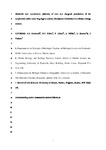Metabolic and reproductive plasticity of core and marginal populations of the eurythermic saline water bug Sigara selecta (Hemiptera: Corixidae) in a climate change context
| dc.contributor.author | Carbonell, JA | |
| dc.contributor.author | Bilton, DT | |
| dc.contributor.author | Calosi, P | |
| dc.contributor.author | Millán, A | |
| dc.contributor.author | Stewart, A | |
| dc.contributor.author | Velasco, J | |
| dc.date.accessioned | 2016-12-12T09:16:37Z | |
| dc.date.available | 2016-12-12T09:16:37Z | |
| dc.date.issued | 2017-04 | |
| dc.identifier.issn | 0022-1910 | |
| dc.identifier.issn | 1879-1611 | |
| dc.identifier.uri | http://hdl.handle.net/10026.1/8108 | |
| dc.description.abstract |
Ongoing climate change is driving dramatic range shifts in diverse taxa worldwide, and species responses to global change are likely to be determined largely by population responses at geographical range margins. Here we investigate the metabolic and reproductive plasticity in response to water temperature and salinity variation of two populations of the eurythermic saline water bug Sigara selecta: one population located close to the northern edge of its distribution, in a relatively cold, thermally stable region (SE England - 'marginal'), and one close to the range centre, in a warmer and more thermally variable Mediterranean climate (SE Spain - 'core'). We compared metabolic and oviposition rates and egg size, following exposure to one of four different combinations of temperature (15 and 25°C) and salinity (10 and 35gL-1). Oviposition rate was significantly higher in the marginal population, although eggs laid were smaller overall. No significant differences in oxygen consumption rates were found between core and marginal populations, although the marginal population showed higher levels of plasticity in both metabolic and reproductive traits. Our results suggest that population-specific responses to environmental change are complex and may be mediated by differences in phenotypic plasticity. In S. selecta, the higher plasticity of the marginal population may facilitate both its persistence in current habitats and northward expansion with future climatic warming. The less plastic core population may be able to buffer current environmental variability with minor changes in metabolism and fecundity, but could be prone to extinction if temperature and salinity changes exceed physiological tolerance limits in the future. | |
| dc.format.extent | 59-66 | |
| dc.format.medium | Print-Electronic | |
| dc.language | en | |
| dc.language.iso | en | |
| dc.publisher | Elsevier BV | |
| dc.subject | Ecophysiology | |
| dc.subject | Range margins | |
| dc.subject | Metabolic rate | |
| dc.subject | Fecundity | |
| dc.subject | Trade-offs | |
| dc.subject | Global change | |
| dc.title | Metabolic and reproductive plasticity of core and marginal populations of the eurythermic saline water bug Sigara selecta (Hemiptera: Corixidae) in a climate change context | |
| dc.type | journal-article | |
| dc.type | Article | |
| plymouth.author-url | https://www.ncbi.nlm.nih.gov/pubmed/27915134 | |
| plymouth.volume | 98 | |
| plymouth.publication-status | Published | |
| plymouth.journal | Journal of Insect Physiology | |
| dc.identifier.doi | 10.1016/j.jinsphys.2016.11.015 | |
| plymouth.organisational-group | /Plymouth | |
| plymouth.organisational-group | /Plymouth/Faculty of Science and Engineering | |
| plymouth.organisational-group | /Plymouth/Faculty of Science and Engineering/School of Biological and Marine Sciences | |
| plymouth.organisational-group | /Plymouth/REF 2021 Researchers by UoA | |
| plymouth.organisational-group | /Plymouth/REF 2021 Researchers by UoA/UoA07 Earth Systems and Environmental Sciences | |
| plymouth.organisational-group | /Plymouth/Research Groups | |
| plymouth.organisational-group | /Plymouth/Research Groups/Marine Institute | |
| plymouth.organisational-group | /Plymouth/Users by role | |
| plymouth.organisational-group | /Plymouth/Users by role/Academics | |
| dc.publisher.place | England | |
| dcterms.dateAccepted | 2016-11-28 | |
| dc.rights.embargodate | 2017-11-30 | |
| dc.identifier.eissn | 1879-1611 | |
| dc.rights.embargoperiod | 48 months | |
| rioxxterms.versionofrecord | 10.1016/j.jinsphys.2016.11.015 | |
| rioxxterms.licenseref.uri | http://www.rioxx.net/licenses/under-embargo-all-rights-reserved | |
| rioxxterms.licenseref.startdate | 2017-04 | |
| rioxxterms.type | Journal Article/Review |


